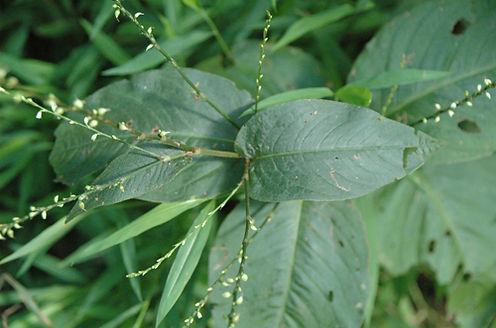jumpseed (Persicaria virginianum)
COMMON NAMES:
Virginia knotweed
Virginia smartweed
woodland knotweed
SCIENTIFIC SYNONYMS:
Persicaria virginiana (L.) Gaertn.
Polygonum virginianum L.
Tovara virginiana (L.) Raf.
Antenoron virginianum (L.) Roberty & Vautier
Persicaria virginiana (L.) Gaertn.
Polygonum virginianum L. var. glaberrimum (Fernald) Steyerm.
Tovara virginiana (L.) Raf.
Tovara virginiana (L.) Raf. var. glaberrima Fernald
CONFIRMATION STATUS: Pending confirmation.
TAXONOMY: The currently accepted scientific name for jumpseed is
Persicaria virginiana (L.) Gaertn. The genus was formerly included in
Genus Polygonum (Polygonum, is derived from the Greek words polys ,
"many," and gonu , "knee or joint," hence "many joints" because of the
thickened joints on the stem).
Based on available evidence, the species occurring in Sky Meadows Park
is believed to be Persicaria virginianum; however, given the large number
of species of Genus Persicaria, subsequent research will be necessary to
confirm identification.
Thirteen species of the often difficult to distinguish Genus Persicaria
have been recorded as occurring in Facquier County. To assist the visitor
in determining which Persicaria species they may encounter, the follow-
ing list is provided with flower color.
Persicaria amphibia - pink;
Persicaria arifolia - pink/red;
Persicaria hydropiper - pink/white
Persicaria hydropiperoides - pink/white
Persicaria lapathifolia - greensih white/pink
Persicaria longiseta - pinkish green
Persicaria maculosa - white/pink/red
Persicaria orientalis - pink/red
Persicaria pensylvanica - greenish white/red
Persicaria perfoliata - greensih white
Persicaria punctata - greensih white/white
Persicaria sagittata - greensih white/white, tinged pink/red
Persicaria virginiana - greenish white/white
NATIVE STATUS: Native, United States and Canada.
GENERAL BOTANICAL CHARACTERISTICS:
Habit: Jumpseed is a native, erect, perennial non-woody forb, general-
ly 20 to 40 inches tall with rust colored hairy stems (hairy above, more glabrescent below) and nodes. The stem arises from a rhizome.
Leaves: The leaves are alternate, extending from the stem on a petiolate,
often hairy on both surfaces (may be smooth on bottom), with large leaves
up to 6" long, broad, lance- like to oval with a sharp tip. The inflorescence
is 4"-16" long, very thin, spike-like, interrupted, flowers loosely arranged,
with terminal clusters.
Flowers: Flowers white to greenish (or even pinksih), 4-parted , 1/8" long,
petals and petal-like sepals, stamens typically 4, filaments whitish and hair-
less, 2 mm long. Anthers pale yellow to whitish, -1mm long; two styles,
persistent in fruit to form a "beak".
Fruit/Seeds: The fruit is a dry, oval seed with a hooked tip that "jumps"
off (or "springs") the plant when touched.
Roots: Roots are rhizomatous.
REGENERATION PROCESS: Tension in the articulation of the pedi-
cels is sufficient to throw mature achenes 3-4 m when the inflor- escence
is bumped, and the persistent, hooked styles aid in the dispersal of achenes
in the fur of animals. Often described as "jumping" or "springing" off the
plant.
HABITAT TYPES: Jumpseed can be found in rich deciduous forests,
floodplain forests, dry woodlands, thickets, riverbanks, cliffs and rocks.
SITE CHARACTERISTICS: Jumpseed prefers shade to semi-shade in
moist situations. Primarily a lowland plant, it can found up to an altitude
of 1500 feet.
SEASONAL DEVELOPMENT: Flowering time is from mid summer
to fall (July through September).
GENERAL DISTRIBUTION: Jumpseed is primarily a species of the
eastern United States. It occurs from Florida north to New England, and
extends west to Texas north through Oklahoma and Nebraska. It is found throughout the Ohio Valley and into Ontario and Quebec. It does not nat-
urally occur in the southwest, Rocky Mountain states, far western and northwestern United States, or the maritime provinces of Canada.
SKY MEADOWS DISTRIBUTION: To be determined.
IMPORTANCE AND USES: Insufficient information is currently available concerning the fauna relationships with jumpseed. Persicaria species are oc-
casionally eaten by humans and are used as food plants by the larvae of some Lepidoptera species.
A hot infusion of leaves with bark of honey-locust (Gleditsia triacanthos)
was used by the Cherokee to treat whooping cough.

Park Activities
Calendar of Events
Volunteer Programs
Sky Meadows Park
Location
Geography
Habitats
Trails
Visiting Park
Crooked Run Valley
Special Projects

